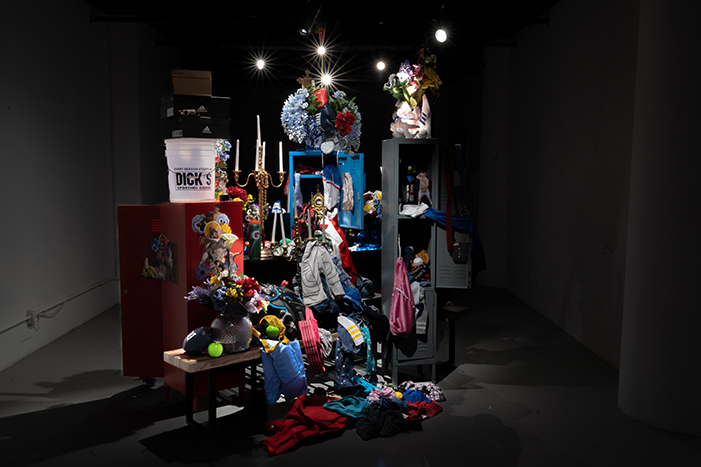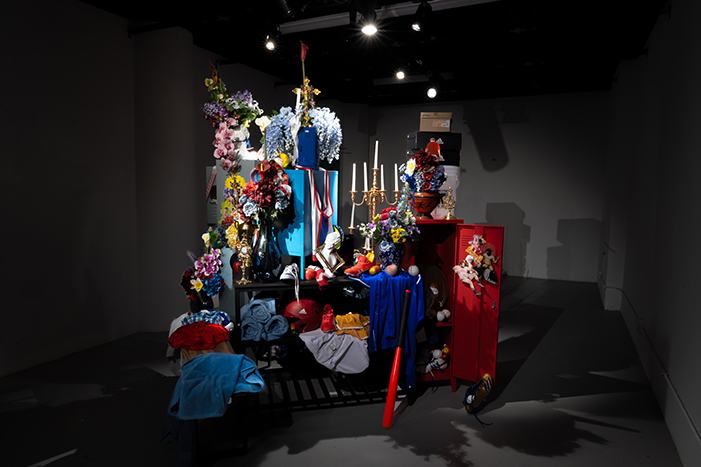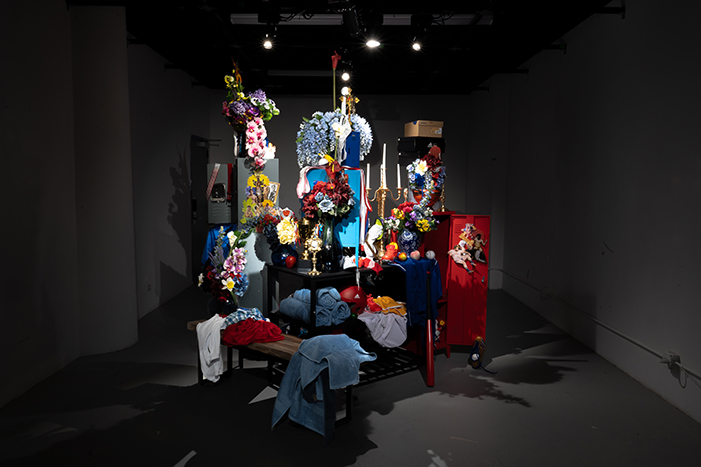Description of My Work
The work for my thesis, The Cathedral of the Most Divine Bodies of the Martyrs in Heavenly Ecstasy, is inspired by two disparate aesthetics that, when combined, offer a meaningful reflection on the imbued object. The work is a sculpture of objects referencing two worlds: the Church and the locker room. I consider both highly homophobic spaces with the ability to reveal homoerotica through specific contexts such as Renaissance and Mannerist heroic male nudity or communal showers. The work spills and towers as though it were a cathedral in miniature. Many of the pieces utilized in the sculpture come from homophobic sources, but I have reclaimed and transformed them into symbols of joy. While some objects are more self-evident—the multitudes of sports objects—others are more esoteric. My practice as an artist is rooted in citation and symbolism; each object holds a specific symbol or citation.
Placed around the space are reliquaries. In the Catholic tradition, reliquaries are objects of devotion that contain bodily fragments of a saint or martyr. The reliquaries used in this work all contain objects referencing sexual experiences such as losing my virginity or when I hooked up with a priest in the Vatican. Likewise, much of the underwear used in this piece is from sexual partners and is also a form of relic.
Other significant components of the work include the flowers and collage elements. The flowers are a reference to altar flowers, and each flower was chosen for its connection to gay history; examples include the pansy, which refers to the slur used against gay men, the hyacinth for the myth of Hyacinthus and Apollo, and the calla lily is an homage to Robert Mapplethorpe’s photographs. Collage abounds within the work and evokes the feeling of frescoes, church paintings, and the pinups found in lockers. These are all primarily self-portraits as I place myself within the imagery utilized and reference my vast research archive of gay history, homoerotica, and pornography.
I find myself reflecting on the word sanctuary when I sit with this work. I find it a sanctuary, a place for refuge and joy. While traditional church spaces have felt exclusionary to me, I have made a space that I am not only welcome in but central to.
Research and Themes
The research for this work started with an examination of potential moments of queerness within the Bible so that I might envision a new form of queer theology that could be represented through art. This led to examining the imagery of the Eucharist. This ceremony, commanded in the Gospels by Jesus, underpins all forms of worship. Church architecture is centered around the altar, which was inspired by the dining table. Transformed into a highly stylized ritual, the Eucharist, as instituted, was a call to remember Christ by partaking in a meal. Jesus, at the Feast of the Passover, broke bread and said this represented his body and then blessed a cup of wine, saying this was his blood. Catholic teaching holds that the Apostles believed the bread and wine physically transformed—transubstantiated—and became the actual flesh and blood of Jesus as they consumed it. While it might be easier to argue a cannibalistic reading (the Romans did), I believe that the ritual importance elevates this to imagery of fellatio. It is a ritual of receiving the body through the mouth. The priest, after blessing the bread, places it on the participant’s tongue in an act of penetration. It was common in Catholic tradition prior to the reforms of the late 20th century and is still common in traditions such as the Scottish Episcopal Church to kneel before the priest offering communion, further enhancing the imagery of fellatio.
The final night of Jesus’ life is rife with other homoerotic undertones as well. Particularly the washing of the Disciples’ feet. I argue that the act of washing the feet is a euphemism for sexual intercourse between Jesus and his followers. Feet are commonly used as a euphemism for genitalia in the Bible: Ezekiel 16 conveys Jerusalem as a harlot and charges her with uncovering her feet for whoever is interested, 1 Samuel 24 depicts Saul urinating in a cave, but describes him “covering his feet,” and Ruth 3 depicts Ruth seducing Boaz into marriage by uncovering his feet. This imagery persists in John 13, where Jesus washes the feet of the disciples.
First, Jesus removed his clothes, wrapped himself in a towel, and then began to wash the feet of each disciple. Then, when he is finished, he dries the feet of each disciple with the towel he has draped around his naked body. Ezekiel 16 and Ruth 3 make explicit reference to turning up the corner of a garment as a further implication of sexual intercourse. To dry their feet, Jesus would have had to turn up the corner of his towel-cum-garment to dry their feet. Which further enhances the innuendo and support for this reading. There is also a status element to consider. Most scholars consider Jesus doing this as an act of servitude akin to a servant for a master, as is traditional at the time, but it was also common for women to wash men’s feet as a devotional act. I believe that is what is happening here: Jesus showing devotion as a wife.
Scholars like Tat-Siong Benny Liew will argue a potential queering of gender here. Still, in many ways, this reinforces a heteronormative view of the relationship between Christ and his followers. Instead, I see Jesus as the receptive sexual partner, bottom, to use the colloquial term. This gets further enhanced in the imagery of Jesus being pierced in the side by the spear of the Roman soldier after his crucifixion. Similar imagery exists with Saint Sebastian, who has been explicitly appropriated by gay culture. This reflection and interpretation of the crucifixion led my research into thoughts on proposing a new queer theology and building a church for it to inhabit.
These church elements become enjoined with imagery from locker rooms. Just like a church, I consider the locker room a source of simultaneous homophobia and homoerotica. Like the church, the locker room has also featured in many forms of gay fetish and kink fantasies. This also provided an additional angle for Jesus’ foot-washing. A common trope found in gay pornography surrounding locker rooms is a man smelling the socks and shoes of another man—generally covertly. These act as an imbued object standing in for the original man. Socks are also used by Robert Rauschenberg for the same reason in his Combines, as noted by Jonathan Katz and Lisa Wainwright. Carrying through the religious metaphor, I consider these socks and shoes to be reliquaries.
In the Catholic tradition, reliquaries hold body parts or objects closely related to saints and martyrs. They are intercessory devices, meaning one can use them during prayer, and the saint or martyr is said to intercede on your behalf to God. It is a requirement for a Catholic church altar to have the relics of at least two figures, and many churches feature numerous relics and reliquaries in different spaces of the church and side chapels. Relics of famous saints or objects, such as the cross Jesus was crucified on, were significant tourist attractions and would bring importance to the church that held them. Inspired by this work, I decided to create reliquaries that would speak to specific sexual experiences. These particular moments of intimacy are over, and all that remains are the physical artifacts. The first person I had sex with asked to trade underwear, and that was something I decided to keep doing to have trophies of those connections.
Ultimately, these elements all combine to create the image of a cathedral: flowers and lockers rise towards the sky like great Gothic spires, locker interiors become chapels and altar spaces, collages become church paintings and stained glass telling stories to the viewer, and sound becomes constant liturgy celebrating divine pleasure. I have placed myself as God of this all because the current God seems to have failed at their creation. Ultimately, this work elucidates a new theology; I hope you choose to join.
Artist Statement
I am a relentless fantasist. From a young age, I saw the world through a haze of make-believe, perceiving fantastical realms beneath everyday life. These worlds became even more essential as I came out as gay and faced adverse reactions. I could retreat into my own fantasies where I could be and do anything. This play led me on a creative journey from childhood make-believe to theatre, and amidst a global pandemic, photomontage. Photomontage opened a world of possibilities, translating the vibrant universes within my mind into a tangible object. Most recently, I have started building physical worlds out of my photomontages. In these works, physical objects and photomontage combine to create spaces for the viewer to inhabit.
Central to all my work is the self-portrait. This enhances the fact that these are all realms made for me. While I am inviting the viewer into these worlds, they are guests. Ultimately, these worlds exist for my mind to play in. At first, I was hesitant to incorporate my body as it does not fit the ideal gay body. Still, upon further reflection, I realized this offered a decisive rejection of idealized beauty.
My work is intensely autobiographical and often speaks to specific moments within my life. I am obsessed with research and archives; my work is an unconventional repository of this information. I like to think of each piece as a visual library card catalog. My work, through juxtaposition and merging, shows threads of queer history from the earliest days of society through to the contemporary age. It offers reflections such as the connection between gay men and flowers and how, since ancient Egypt and Greece, gay men have been strongly associated with specific flowers.
These are then filtered through my own reflections and memories. A poppy might reference Adonis, but they also grew abundantly in the home gardens of the person I lost my virginity to. I can’t smell poppies without thinking of him. However, as Lady Gaga says in the prelude to her Marry the Night music video, memories cannot be trusted because it is easier to “prefer to remember them in an artistic way,” which brings me back to the feelings of fantasy and embellishment.
Ultimately, these feelings of fantasy are an effort to find liberation; I feel constantly constrained by society, gay culture, friends, family, and others and to fit into a specific mold. My artwork is where I can be free, and I hope others find that freedom as well.




